
Lakshmana, also known as Laxmana, Lakhan, Saumitra, and Ramanuja, is a Hindu god and the younger brother of Rama in the Hindu epic Ramayana. He is considered as an incarnation of Shesha, the lord of serpents. Lakshmana was married to Urmila, and is known for his loyalty and dedication towards Rama.

In the Hindu epic Ramayana, Maricha, or Mareecha is a rakshasha, who was killed by Rama, the hero of the epic and an avatar of Vishnu. He is mentioned as an ally of Ravana, the antagonist of the epic. His most notable exploit is his role in the kidnapping of Sita, Rama's wife. His son Kalanemi was killed by Hanuman.

Sita, also known as Siya, Janaki and Maithili, is a Hindu goddess and the female protagonist of the Hindu epic Ramayana. Sita is the consort of Rama, the avatar of god Vishnu, and is regarded as an avatar of goddess Lakshmi. She is the chief goddess of the Ramanandi Sampradaya and is the goddess of beauty and devotion. Sita's birthday is celebrated every year on the occasion of Sita Navami.
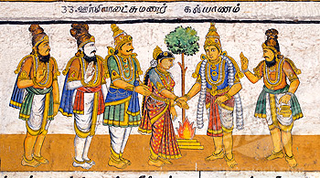
Urmila, is a Hindu goddess and the princess of Videha in the Hindu epic Ramayana. She is considered to be an avatāra of Nagalakshmi, the serpent goddess. Urmila was married to Lakshmana and is known for her dedication towards her husband, for her sacrifice.

Shrutakirti is a princess of Videha, in the Hindu epic Ramayana. She is the wife of Shatrughna and is considered an incarnation of the discus of goddess Lakshmi. Shrutakirti is known for her foresight and dedication.

Mandavi is a princess of Videha in the Hindu epic Ramayana. She is the wife of Bharata and is considered an incarnation of the conch shell of goddess Lakshmi. Mandavi is known for her sacrifice and perseverance.
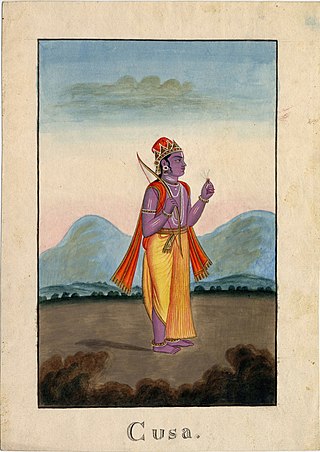
Kusha and his younger twin brother Lava were the children of Rama and Sita. Their story is recounted in the Hindu epic, the Ramayana. Hindu traditions claim he ruled the entire region of Kashmir, Indus River and Hindu Kush as frontier lands of India known as Hindu Kush Kshetra and founded the city of Kashmir in the valley and Kasur with Lavapuri of Lava in base lands, though local lore contends Kasur was founded in 1525 by Pashtun migrants. His brother Lava is traditionally believed to have founded Lavapuri.
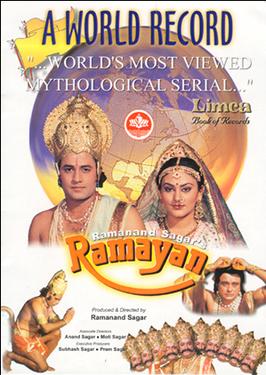
Ramayan is an Indian Hindi-language epic television series based on ancient Indian Sanskrit Epic Ramayana. The show was created, written, and directed by Ramanand Sagar. It originally aired between 1987 and 1988 on DD National and it was narrated by Ashok Kumar and the director Ramanand Sagar. The music was composed by Ravindra Jain. During its run, the show became the most watched television series in the world, garnering a viewership of 82 percent. The repeat telecast was aired on 20 different channels in 17 countries on all the five continents at different times. The success of the series was documented well by the media. According to BBC, the serial has been viewed by over 650 million viewers. Each episode of the series reportedly earned DD National ₹40 lakh.
Luv Kush is an Indian television series that ran from 1988 to 1989. It was created, written, produced, and directed by Ramanand Sagar. It is a follow-up Ramayan, featuring mostly the same cast and production crew. Luv Kush covers the last book — the Uttarakāṇḍa — of the ancient Indian epic Ramayana, following Rama's coronation, especially focusing on his children, twins Kusha and Lava.
Ramayan is an Indian television series depicting the story of Rama and based on stories from classic Indian literature. The 2008 release is a reboot of the 1987 Ramayan television series of the same name. The plot derives from Valmiki's Ramayan, Tulsidas's Ramcharitmanas and Chakbasta's Urdu Ramayan with aspects of other works. The television series was produced by Sagar Arts and aired on NDTV Imagine. This Show Was Re-Aired On Dangal TV while the entire episodes of this show can be watched on Dangal Play app.
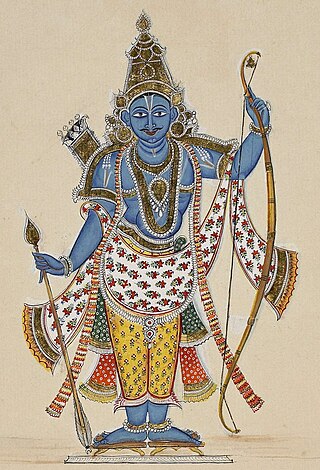
Rama is a major deity in Hinduism. He is worshipped as the seventh and one of the most popular avatars of Vishnu. In Rama-centric Hindu traditions, he is considered the Supreme Being. Also considered as the ideal man, Rama is the male protagonist of the Hindu epic Ramayana. His birth is celebrated every year on Rama Navami, which falls on the ninth day of the bright half of the lunar cycle of Chaitra (March–April), the first month in the Hindu calendar.

Sri Rama Rajyam is a 2011 Indian Telugu-language devotional film directed by Bapu who co-wrote the film with Mullapudi Venkata Ramana, and produced by Yalamanchali Saibabu. The film stars Nandamuri Balakrishna, Nayanthara, Akkineni Nageswara Rao, Srikanth, and its music was composed by Ilaiyaraaja, which won him Nandi Award for Best Music Director. Sri Rama Rajyam is a remake of the 1963 blockbuster film Lava Kusa.
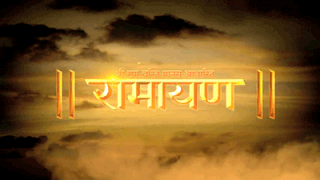
Ramayan: Sabke Jeevan Ka Aadhar is an Indian television series produced by Sagar Pictures which aired on Zee TV. It is an adaptation of Ramcharitmanas.
Ramleela – Ajay Devgn Ke Saath, commonly known as Ramleela, is a mythological on-stage musical drama, based on the Indian epic poem Ramayan. The show premiered on 21 October 2012 on Life OK and completed the story in five episodes on 18 November 2012. The show was narrated by Bollywood actor Ajay Devgn, who provided a prologue at the beginning of each episode or act. The show aired during the period from Dussehra in October till Diwali in November.

Sita Samahit Sthal (Sitamarhi), the holy place of Sitamarhi is situated between Prayagraj and Varanasi, near the national highway No. 2 and also connected with Prayagraj and Varanasi railway line with Jangiganj, the nearest railway station. It is a well known Hindu pilgrimage in the poorvanchal region of Uttar Pradesh.

Siya Ke Ram is an Indian television series on Star Plus produced by Nikhil Sinha under the banner of Triangle Film Company. This show presents the epic Ramayana, the story of Rama and Devi Sita from Sita's perspective. The show features Madirakshi Mundle and Ashish Sharma playing as Goddess Sita and Lord Rama, respectively, and Karthik Jayaram as Raavan. It premiered on 16 November 2015 and ended on 4 November 2016.

Ramayan is a Hindi TV series that was aired on Zee TV in 2001. It is a television adaptation of the ancient Indian epic of the same name, and is primarily based on Valmiki's Ramayana, Tulsidas Ramcharitramanas, Kalidasa's Raghuvaṃśa and Kambar's Kambh Ramayana. It was produced and directed by Baldev Raj Chopra and Ravi Chopra.

Ram Siya Ke Luv Kush is an Indian mythological drama television series, which aired on Colors TV from 5 August 2019 to 10 February 2020. The series focused on the story of Rama and Sita as well as their children Luv and Kush. It starred Shivya Pathania, Himanshu Soni, Krish Chauhan, and Harshit Kabra in lead roles.
Shrimad Ramayan is an Indian Hindi-language television series that premiered from 1 January 2024 to 9 August 2024 on Sony TV and airing on Sony SAB since 12 August 2024. Produced by Siddharth Kumar Tewary under the banner of Swastik Productions, the series is based on the epic Ramayana. It stars Sujay Reu as Rama and Prachi Bansal as Sita.
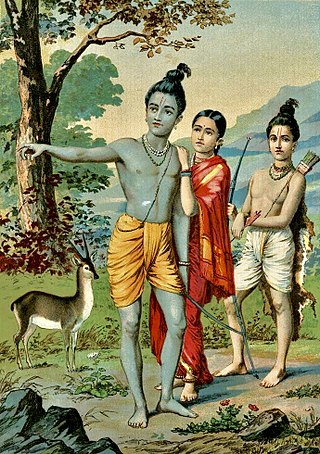
The exile of Rama is an event featured in the Ramayana, and is an important period in the life of Rama. In the epic, Rama is exiled by his father, Dasharatha, under the urging of his step-mother Kaikeyi, accompanied by his wife Sita and half-brother Lakshmana for 14 years. Rama's exile is a prelude to subsequent events of the epic, such as abduction of his wife Sita, his meeting with Hanuman and Sugriva, his battle with Ravana, and ultimately, the killing of Ravana, the purpose for which Vishnu had incarnated himself as Rama.
















